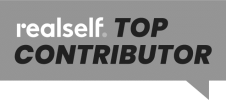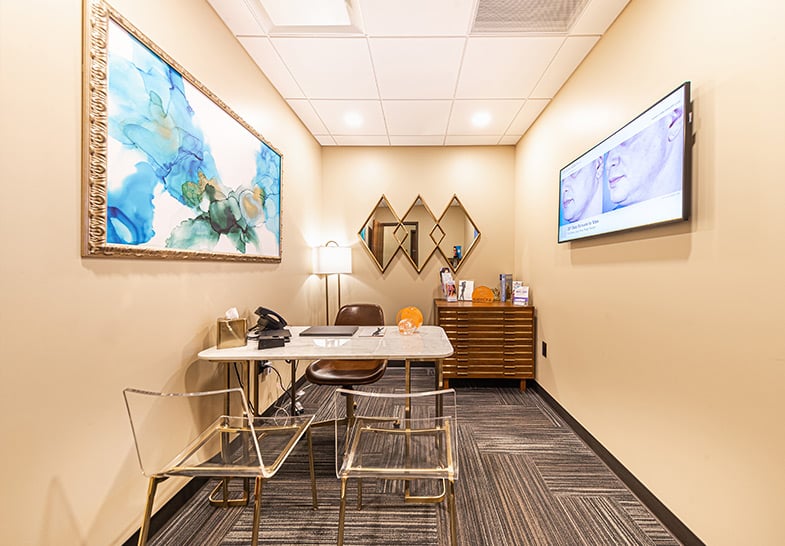Botox® for Sweating (Hyperhidrosis) in Virginia, Washington D.C. and Maryland.
Embark on a journey of aesthetic excellence with The Naderi Center. Experience unparalleled artistry and precision for transformative beauty.
Botox® for Sweating Benefits
Take control of excessive sweating with Botox® at The Naderi Center. Our skilled providers use this quick, proven treatment to target overactive sweat glands, helping you stay dry, confident, and comfortable in any situation.
Enhanced Social Interaction
Make handshakes and hugs without the worry of excess sweating, boosting your confidence in social settings.
Improved Work Performance
A sweat-free life means better concentration and focus, enabling you to excel in your professional endeavors.
Freedom in Fashion
Enjoy wearing whatever you want, from silk to cotton, without the constant fear of sweat stains ruining your attire.


What is Hyperhidrosis?
Hyperhidrosis or excessive sweating is an abnormal reaction that is not necessarily related to heat or exercise. The body produces more sweat than is required to regulate its body temperature. Individuals affected by hyperhidrosis may find that their sweat is constantly soaking through clothing or that they have to wipe their palms dry. It is estimated that 1.3 million Americans have been diagnosed with severe hyperhidrosis. Severe sweating can interfere with jobs, social life, personal relationships and confidence level.
Primary hyperhidrosis is most often times diagnosed as being idiopathic, that means that there is no specific cause for the excessive sweating. Secondary hyperhidrosis usually has a cause that can be identified such as emotional and psychological triggers, heat, spicy foods, endocrine (hormonal) disorders, physical activity, etc.

Hyperhidrosis Diagnosis Criteria
- Excessive sweating that last for 6 or more months, with a frequency of more than once a week
- Impairment of daily activities
- Bilateral (both sides) symmetric sweating
- Positive family history of members with excessive sweating
- Onset before the age of 25
- Cessation of focal sweating while asleep
- The most common areas of focal hyperhidrosis are the axilla (armpit), palms, and soles
Expected Results after Botox® for the Treatment of Excess Sweating
- Reduced sweating of treatment area (palms, armpits, soles of feet)
- Improved self confidence
Ideal Candidates for Botox® treatment for Hyperhidrosis
Good Candidates for Botox® treatment for hyperhidrosis
- Experience moderate to severe palm, armpit, and/or soles of feet sweating
- Excess sweating can not be controlled by deodorant or anti-perspirant
- Are willing to undergo injections every 2-3 months to maintain results
Hyperhidrosis Disease Severity Scale
Adapted from the Hyperhidrosis Disease Severity Scale study.
| Score | Patient Response |
|---|---|
| 1 | My underarm sweating is never noticeable and never interferes with my daily activities. |
| 2 | My underarm sweating is tolerable but sometimes interferes with my daily activities. |
| 3 | My underarm sweating is barely tolerable and frequently interferes with my daily activities. |
| 4 | My underarm sweating is intolerable and always interferes with my daily activities. |
Techniques for Treatment of Hyperhidrosis
The most common over the counter treatment for excessive sweating is deodorant and antiperspirant use. However, antiperspirants and deodorants are usually only applied to the underarms and cannot help with plantar sweating or palmar sweating. Some patients find that even the strongest antiperspirants containing aluminum chloride do not do much to decrease the amount of sweat produced. Even if antiperspirants can help they are usually short-acting and would require multiple applications throughout the day.
Your physician can suggest both surgical as well as non-surgical treatment options to help relieve hyperhidrosis. One of the most common yet under marketed uses for Botox® is for excessive sweating. Most patients associate Botox® as being an anti-aging product used to decrease the appearance of wrinkles on the face.

What most patients don’t know is that Botox® was FDA approved in 2004 for the treatment of excessive sweating in the axilla (underarm).
Botox® weakens the nerves around the sweat glands to help decrease sweat production. Botox® injections to the sweat glands can afford patients up to 4-6 months of relief from sweating. Typically 50-100 units of Botox® is injected per side of the treatment area. Underarms and palms typically require Botox® treatments are every 2-3 times a year.
The most invasive means for treating hyperhidrosis is to undergo a sweat gland reduction procedure. In a glandular reduction procedure the patient’s sweat glands are permanently and surgically shaven off. Although not 100 percent of the sweat glands are removed, the amount surgically excised is significant enough to produce a noticeable decrease is sweat production. Sweat gland excision is typically performed in office under local anesthesia.
Botox® for Hyperhidrosis
Botox® works by blocking the nerves responsible for activating your sweat glands. Normally, your nervous system activates your sweat glands when your body’s temperature rises. This is how your body automatically cools itself. In people with hyperhidrosis, the nerves that signal the sweat glands are overactive.
Botox® injections in the vicinity of the nerves responsible for sweating helps decrease the amount of signal these nerves are sending to the sweat glands. The blockage of these nerve impulses essentially helps to reduce sweat production.
Cost of Botox® Treatment for Hyperhidrosis
Preparation for Botox® treatment for excess sweating
2 Weeks Prior To Injection
- To reduce and minimize bruising please follow our dietary restrictions. For 2 weeks before your appointment avoid nuts, seeds, fish, fish oil, NSAIDs, supplements, and anything that prolongs bleeding.
Day Of Injection
- Wear as little to no makeup as possible
- Make sure you have eaten and your blood sugar is not low
- Make sure you have drank plenty of water and are not dehydrated
- Dress in cool comfortable clothes
- Come in at least 30 minutes ahead of your appointment if you would like numbing cream
- Make your appointment for the next time before leaving the office since our doctors’ schedules book out months in advance
Recovery after Botox® treatment for hyperhidrosis
- Pinpoint bleeding may occur and will resolve quickly.
- Mild temporary bruising and or sensitivity around the injection site may develop. This will resolve within the first week after treatment.
- Any immediate redness or swelling will subside within an hour.
- Use a small bag of frozen pees in a sandwich bag or crushed ice to gently ice the area. No heavy ice bags. Ice for 20 minutes on and 20 minutes off. Continue the icing for 48 hours.
- No gym or exercise for 48 hours after injection.
- Do not manipulate, massage, rub, or poke the area.
- Taking Arnica tablets and eating pineapples can reduce bruising and swelling.
Risks, Safety, and Potential Complications of Botox®treatment for Hyperhidrosis
Botox® injections to the sweat glands can be contraindicated in patients that have an underlying medical condition that is causing hyperhidrosis, are taking blood thinners, have severe blood clotting disorders or have had surgical debulking of their sweat glands.
The primary disadvantage to treating hyperhidrosis with Botox® is the impermanence. Typically, the treatment lasts at most six months. Multiple treatments will be required. Patients who have had more than four treatments are less tolerant of symptoms once they become accustomed to sweating less (anhydrosis).
Botox® Experts at The Naderi Center
At The Naderi Center, all of our Botox® specialists are physicians that are highly skilled and experienced with the use of Botox® for hyperhidrosis. Many patients routinely come to The Naderi Center to improve palm and armpit sweating through Botox® injections.
To find out more about if Botox® treatment for excess sweating is right for you contact The Naderi Center to schedule a consultation. Contact the Northern Virginia office at 703-481-0002 or the Chevy Chase, Maryland office at 301-222-2020. Although The Naderi Center is conveniently located for patients throughout the Virginia, Maryland, and Washington D.C. area, we have many patients from across the United States who come to our surgeons because they know they are ultra-specialized in their area of cosmetic plastic surgery. Those outside of the immediate area may request a virtual consultation prior to their in office visit.

Botox® for Hyperhidrosis FAQs
What Makes Botox Effective for Sweating?
- Quick Results: Noticeable reduction in sweating within 1–2 weeks of treatment.
- Prolonged Relief: Effects last 4–6 months, with studies showing up to 87% sweat reduction in treated areas.
- Broad Applications: Effective for axillary (underarm), palmar (hand), and plantar (foot) sweating.
What to Expect During the Procedure
- Preparation: The area is cleaned, and a topical numbing cream is applied for comfort.
- Injection: Botox is administered using a fine needle, targeting sweat glands in precise areas.
- Duration: Typically completed within 20–30 minutes as an outpatient procedure.
Is Botox for Sweating Right for You?
Botox is ideal for those with severe hyperhidrosis who have not found relief from other treatments like antiperspirants or medications. It’s especially beneficial for individuals whose sweating significantly impacts their daily lives or confidence.
Why Choose Botox Over Other Treatments?
Botox offers a non-surgical, minimally invasive option with proven efficacy. Unlike topical treatments, it addresses the root cause—overactive sweat glands—offering longer-lasting and more reliable relief.
Does it hurt to treat Hyperhidrosis with Botox®?
The pain associated with armpit or palmar Botox® can be uncomfortable. At The Naderi Center we offer patients complimentary topical numbing crème that is applied 20 minutes prior to the procedure. Some patients describe the sensation of the injection as similar to plucking hair.
How long do Botox® injections for sweating last?
Every patient breaks down Botox® differently, so the duration of the results will vary. Typically, patients experience dry armpits for around 3 to 6 months after receiving Botox® injections. However, exercise and stress can accelerate the body’s metabolic response to Botox®, causing the result to fade quicker.
How long does Botox® treatment to the underarms or palms takes?
Botox® injections to the armpits or palms usually takes our physicians about ten minutes to perform. Minor bruising for a few days can be expected.
What is the typical patient satisfaction rate from treating Hyperhidrosis with Botox®?
Patients who have undergone Botox® injections claim a significant decrease in excess sweat production and are happier with their overall quality of life. Patients also generally feel that Botox® injections work better than other non-surgical options such as antiperspirants and oral medications to reduce sweating.
Is Botox® for Underarm Injections a new treatment modality?
No. The FDA approved Botox® to treat severe underarm sweating in July of 2004.
How do I know if I am a Candidate for Treatment of Hyperhidrois with Botox®?
You may be a candidate for Botox® if your sweating fails to improve with prescription antiperspirants. Botox® has been FDA-approved for people who sweat excessively from their armpits and is commonly used off-label for sweating of the palms. It is best to consult a medical professional to see if you can benefit from Botox® for excessive sweating.
What Botox® injections for sweating office is near me
If you live in the states of Virginia or Maryland, The Naderi Center for Plastic Surgery and Dermatology offers Botox® injections for sweating among its services. For a full list of services, please visit our Locations page.